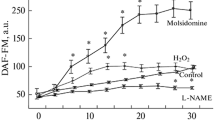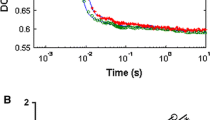Summary
The effect of cadmium ions on the dioxygen affinity, the time-dependent depletion of intracellular polyphosphates, and the elongation of human red blood cells (RBC's) was examined. The incubation of RBC's in the presence of 1 mM Cd2+ at 37°C for more than one hour results in a decrease of the p50 value by 2.5–3.0 mmHg in comparison to controls. The p50 of stripped (phosphate-free) hemoglobin is not affected by the presence of 1 mM Cd2+ (p50=4.8 mmHg at pH 7.2 and 37°C). Experiments with RBC cryolysates demonstrate an apparently competitive effect of 2.3-bisphosphoglycerate (DPG) with cadmium ions on the dioxygen affinity. From 31P NMR spectra, 31P T1 relaxation, and 31P T2 relaxation behavior a more direct evidence for DPG-Cd2+ complexation is obtained. 31P NMR spectra of RBC cryolysates also indicate DPG-Cd2+ complexation. The hydrolysis of free polyphosphates in RBC's incubated at 37°C as monitored by 31P NMR spectra can be noticed after a three-hour lag phase (constant polyphosphate level). This lag phase is lengthened from three hours to four hours in the presence of Cd2+ ions. RBC elongation, as a measure of deformability, decreases slightly upon incubation with 1 mM Cd2+.
Similar content being viewed by others
References
Benesch R, Benesch RE, Yu CJ (1968) Reciprocal binding of oxygen and diphosphoglycerate by human hemoglobin. Proc Natl Acad Sci USA 59: 526
Chapman BE, Kuchel PW, Lovric VA, Raftos JE, Stewart IM (1985) Regeneration of phosphorylated metabolites in stored erythrocytes in an open perfusion system: studies using 31P NMR spectroscopy. Br J Haematol 61: 385
Deslauriers R, Ekiel I, Kroft T, Smith ICP (1982) NMR studies of malaria. 31P nuclear magnetic resonance of blood from mice infected with plasmodium berghei. Biochim Biophys Acta 721: 449
Fabry ME, San George RC (1983) Effect of magnetic susceptibility on nuclear magnetic resonance signals arising from red cells: A warning. Biochemistry 22: 4119
Fossel ET, Solomon AK (1976) Modulation of 2,3-diphosphoglycerate 31P-NMR resonance positions by red cell membrane shape. Biochim Biophys Acta 436: 505
Garty M, Wong K-L, Klaassen CD (1981) Redistribution of cadmium to blood of rats. Toxicol Appl Pharmacol 59: 548
Gersonde K, Overkamp M, Sick H, Trittelvitz E, Junge W (1973) β-Chain allostery in the frozen quaternary T-structure of hemoglobin M Iwate.
Gersonde K, Sick H (1984) Process and apparatus for plotting the oxygen equilibrium curves of blood or hemoglobin solutions. United States Patent No. 4,469,439
Gersonde K, Sick H, Klinge U, Gauch W (1984) In-vitro effects of glucose and insulin on the O2-haemoglobin dissociation curve of human red blood cells. Possible implications in the O2 transport phenomena. Biomed Biochim Acta 43: 39
Haest CWM, Fischer TM, Plasa G, Deuticke B (1980) Stabilization of erythrocyte shape by a chemical increase in membrane shear stiffness. Blood Cells 6: 539
Henderson TO, Costello AJR, Omachi A (1974) Phosphate metabolism in intact human erythrocytes: determination by phosphorus-31 nuclear magnetic resonance spectroscopy. Proc Natl Acad Sci USA 71: 2487
Kabat A-I, Niedworok J, Kedziora J, Blaszczyk J, Bartosz G (1979) Effect of zinc on the oxygen affinity of hemoglobin and the level of 2,3-DPG in normal human red blood cells in vitro. Zentralbl Bakteriol Mikrobiol Hyg [B] 169: 436
Karl C, Pelzer I, Gauch W, Gersonde K, Liedtke B, Jung H (1985). Veränderungen des erythrozytären p50 und seines Einflusses auf den O2-Transport unter intravenöser Tokolyse mit Fenoterol (Partusisten). Z Geburtshilfe Perinatol 189: 18
Klinge U, Pelzer I, Sick H, Gersonde K (1984) Oscillation of the O2 half-saturation pressure and polyphosphate levels in human red blood cells. Biomed Biochim Acta 43: 44
Kunimoto M, Miura T, Kubota K (1985) An apparent acceleration of age-related changes of rat red blood cells by cadmium. Toxicol Appl Pharmacol 77: 451
Lam YF, Lin AK-LC, Ho C (1979) A phosphorus-31 nuclear magnetic resonance investigation of intracellular environment in human normal and sickle cell blood. Blood 54: 196
Mitsumori F (1984) Phosphorus-31 nuclear magnetic resonance studies on intact erythrocytes. Determination of intracellular pH and time course changes in phosphorus metabolites. J Biochem 97: 1551
Nordberg GF, Piscator M, Nordberg M (1971) On the distribution of cadmium in blood. Acta Pharmacol Toxicol 30: 289
Oelshlegel FJ jr, Brewer GJ, Prasad AS, Knutsen C, Shoomaker EB (1973) Effect of zinc on increasing oxygen affinity of sickle and normal red blood cells. Biochem Biophys Res Commun 53: 560
Oelshlegel FJ jr, Brewer GJ, Knutsen C, Prasad AS, Shoomaker EB (1974) Studies on the interaction of zinc with human hemoglobin. Arch Biochem Biophys 163: 742
Oxley ST, Porteous R, Brindle KM, Boyd J, Campbell ID (1984) A multinuclear NMR study of 2,3-bisphosphoglycerate metabolism in the human erythrocyte. Biochim Biophys Acta 805: 19
Perutz MF (1970) Stereochemistry of cooperative effects in haemoglobin. Nature 228: 726
Rabenstein DL, Isab AA, Kadima W, Mohanakrishnan P (1983) A proton nuclear magnetic resonance study of the interaction of cadmium with human erythrocytes. Biochim Biophys Acta 762: 531
Tehrani AY, Lam Y-F, Lin AK-LC, Dosch SF, Ho C (1982) Phosphorus-31 nuclear magnetic resonance studies of human red blood cells. Blood Cells 8: 245
Author information
Authors and Affiliations
Rights and permissions
About this article
Cite this article
Arkowitz, R., Gersonde, K. Effect of cadmium ions on dioxygen affinity and polyphosphate activity of human red blood cells. Blut 56, 185–190 (1988). https://doi.org/10.1007/BF00320750
Received:
Accepted:
Issue Date:
DOI: https://doi.org/10.1007/BF00320750




